10 Delicious Canned Deer Meat Recipes – Easy & Flavorful Dishes!
Have you ever wondered how to turn a simple ingredient into a hearty meal that’s both quick and delicious? Venison, with its rich flavor and lean profile, is a fantastic choice for creating meals that satisfy. Whether you’re a seasoned cook or just starting out, this versatile meat can be the star of your kitchen.
Thank you for reading this post, don't forget to subscribe!Using a pressure canner, you can preserve venison in jars, ensuring it’s ready to use whenever you need it. This process not only saves time but also locks in the natural flavors. Imagine opening a jar of perfectly seasoned meat, ready to transform into a stew, sandwich, or even a quick skillet dish in minutes.
From the first step of sterilizing jars to the final touch of sealing lids, we’ll guide you through the process. With the right tools and a bit of patience, you can create meals that are both practical and flavorful. Let’s dive into the world of venison and discover how easy it is to make delicious dishes at home.
Key Takeaways
- Venison is a versatile and flavorful ingredient for quick meals.
- Using a pressure canner ensures safe and effective preservation.
- Properly sealed jars keep the meat fresh and ready to use.
- Seasoning with garlic, pepper, and salt enhances the natural taste.
- Sterilized jars and lids are essential for successful canning.
Understanding the Basics of Canning Deer Meat
Preserving food at home can be both rewarding and practical, especially when done correctly. Canning is a reliable method to store ingredients like venison, ensuring they remain fresh and flavorful for months. To get started, you’ll need the right tools and a clear understanding of the process.
Essential Tools and Ingredients
To begin, gather your tools. A pressure canner is essential for safely preserving meat. You’ll also need sterilized jars, lids, and a rack to keep the jars stable during the process. Quality ingredients, such as fresh venison and a pinch of salt, are key to achieving the best results.
Sterilizing jars and lids is a crucial step. Wash them in warm, soapy water, and ensure the rims are wiped clean before sealing. This prevents contamination and ensures a proper seal. Having these tools ready sets the foundation for successful canning.
Safety and Pressure Canning Guidelines
Safety is paramount when canning meat. Using a pressure canner ensures that harmful bacteria are eliminated. Follow the manufacturer’s instructions carefully, paying attention to water levels and heat management. Steady heat and proper pressure are critical for safe preservation.
Place the jars on the rack inside the canner, ensuring they don’t touch each other. Maintain the recommended pressure and cooking time for your specific recipe. This process locks in the natural flavors and keeps the meat safe for long-term storage.
By mastering these basics, you’ll be well on your way to creating delicious, home-preserved meals. Whether it’s a hearty stew or a quick skillet dish, properly canned venison is a versatile addition to your kitchen.
Explore Our Top canned deer meat recipes
Transform your kitchen routine with these inspired and easy-to-make dishes. From hearty stews to savory sandwiches, we’ve curated a collection of recipes that showcase the versatility of preserved ingredients. Each dish is designed to bring flavor and convenience to your table.
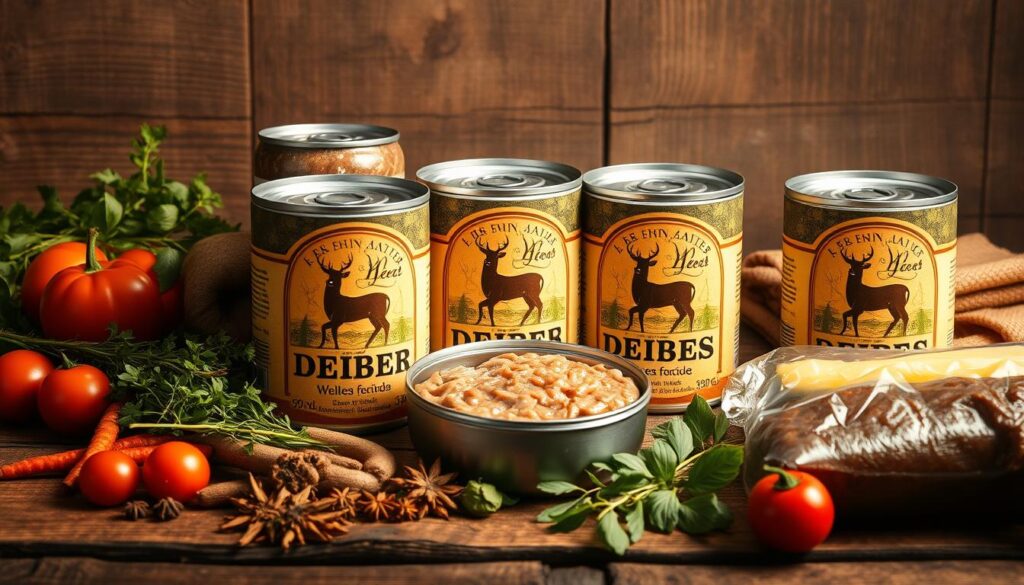
Recipe Inspirations and Variations
Our favorite recipes include French dips, seasoned pot roast, and Italian-inspired dishes with rich gravy. These meals are perfect for busy weeknights or special occasions. By experimenting with seasonings like pepper and garlic, you can create unique flavors every time.
For example, the French dip sandwich has a fascinating history, originating from Los Angeles restaurants. It’s a simple yet satisfying meal that pairs perfectly with a pint of broth. Whether you prefer raw-packed cubes or fully cooked meals, these recipes are adaptable to your needs.
Using a pressure canner ensures your ingredients are preserved safely and retain their natural taste. With just a few minutes of prep time, you can have a delicious meal ready to serve. Try these recipes today and discover how easy it is to elevate your cooking!
Step-by-Step Guide to Canning Process
Mastering the art of preserving food at home starts with understanding the right techniques. Whether you’re new to canning or looking to refine your skills, this guide will walk you through the essentials. From raw pack methods to using a pressure canner effectively, we’ll cover everything you need to know.
Raw Pack and Pre-Cooked Methods
There are two primary methods for canning: raw pack and pre-cooked. The raw pack method involves placing uncooked ingredients directly into the jar. This is ideal for maintaining texture and natural flavors. For best results, add a pinch of salt and pepper to enhance the taste.
Pre-cooking is another option, especially for ground or cubed ingredients. This method helps preserve the texture and prevents mushiness. After cooking, pack the ingredients into sterilized jars, leaving about an inch of headspace. Wipe the rim clean before sealing the lid tightly.
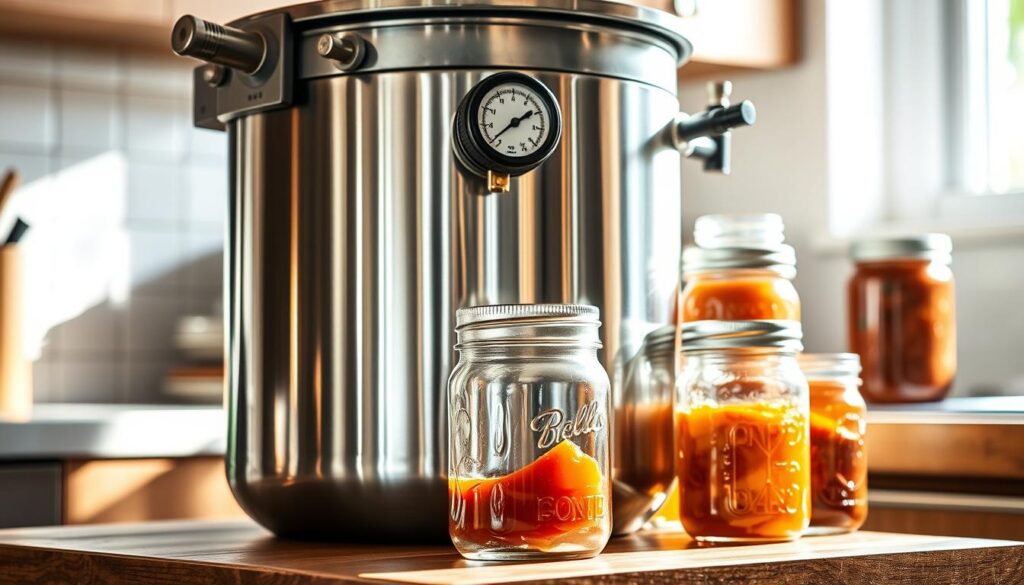
Using a Pressure Canner Effectively
A pressure canner is essential for safely preserving ingredients. Start by placing the jars on the rack inside the canner. Ensure they don’t touch each other. Add enough water to cover the jars by about two inches.
Close the canner and adjust the heat to reach the recommended pressure, typically 10 psi at sea level. Maintain this pressure consistently throughout the process. This ensures that harmful bacteria are eliminated and the ingredients are preserved safely.
Monitoring Cooking Times and Pressure
Proper processing times are crucial for successful canning. For pints, process for 75 minutes, and for quarts, allow 90 minutes. Keep an eye on the gauge to ensure the pressure remains steady. Avoid sudden changes in heat, as this can affect the seal.
Once the processing time is complete, turn off the heat and let the canner cool naturally. Remove the jars carefully and place them on a cloth to cool completely. Check the seals to ensure they’re airtight before storing.
- Raw pack maintains texture and natural flavors.
- Pre-cooking prevents mushiness and preserves quality.
- Use a pressure canner for safe and effective preservation.
- Monitor pressure and processing times carefully.
- Cool jars naturally and check seals before storage.
Enhancing Flavor with Quality Ingredients
Unlocking the full potential of your preserved ingredients starts with the right seasonings. By carefully selecting and combining spices, you can transform simple dishes into gourmet meals. Quality ingredients and proper seasoning are the keys to creating rich, flavorful results every time.
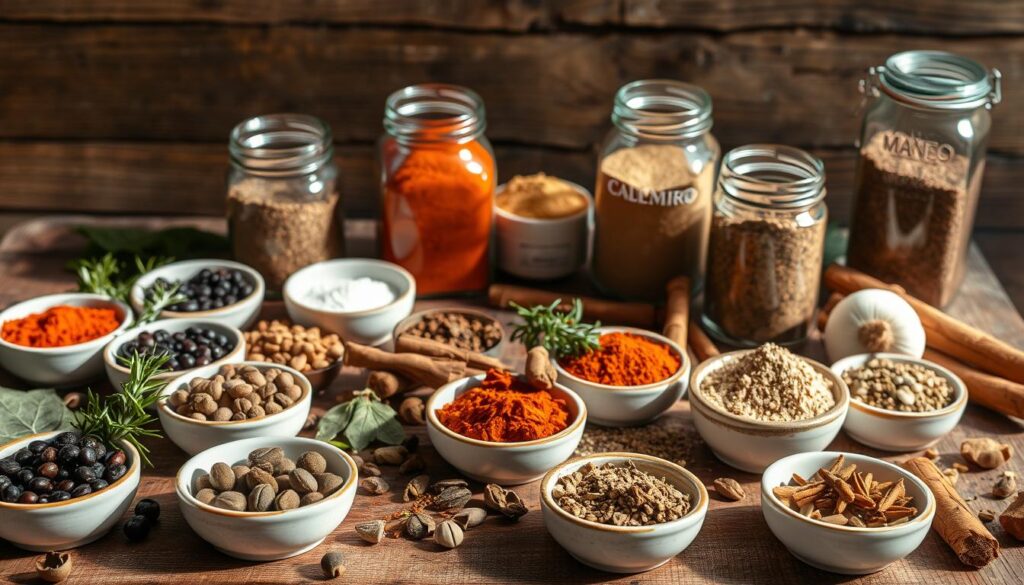
Seasoning Secrets: Salt, Pepper, and Beyond
Seasoning is an art that enhances the natural taste of your ingredients. For every pound of preserved food, use one teaspoon of salt and half a teaspoon of pepper. This ratio ensures a balanced flavor without overpowering the dish.
Experiment with additional spices like minced garlic or green bell peppers to add depth. These ingredients not only enhance taste but also create a unique profile for your meals. Consistency in seasoning is crucial for achieving professional-quality results.
Adding Complementary Ingredients for Rich Broth
A rich broth can elevate your dishes to the next level. Adding onions, garlic, or vegetables during the preservation process infuses the liquid with flavor. This broth becomes a versatile base for soups, stews, and pot roasts.
For best results, use a pressure canner to seal in the flavors. This method ensures that the broth retains its richness and complements the preserved ingredients perfectly. With these tips, you can create meals that are both delicious and satisfying.
| Ingredient | Amount per Pound |
|---|---|
| Salt | 1 teaspoon |
| Pepper | ½ teaspoon |
| Minced Garlic | 1 clove |
| Green Bell Pepper | ¼ cup |
Creative Ways to Serve Your Canned Venison
Discover how to turn your preserved venison into mouthwatering meals that are both quick and satisfying. Whether you’re looking for hearty comfort food or fast weeknight dinners, these ideas will inspire you to make the most of your pantry staples.
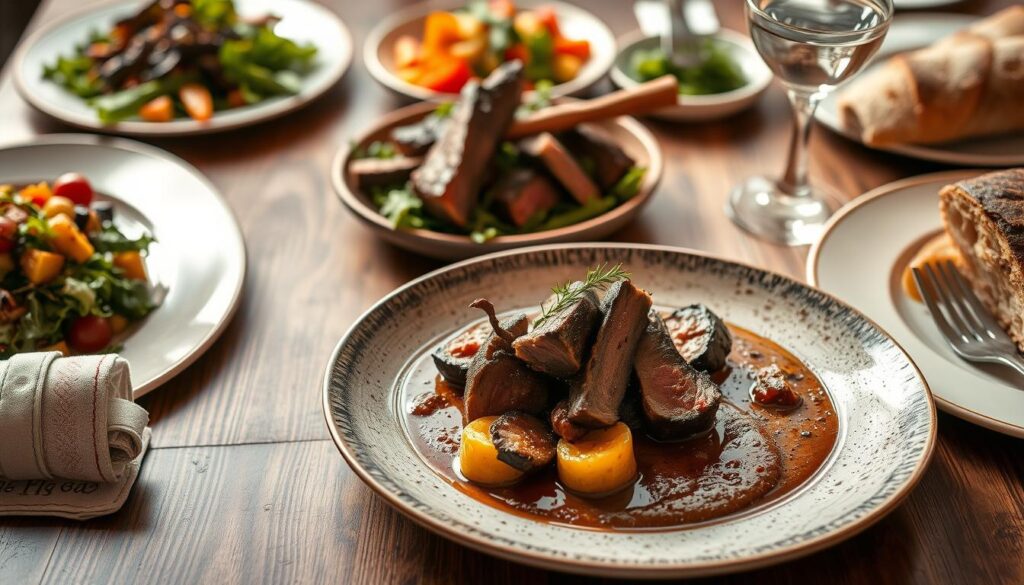
Hearty Soups, Stews, and Pot Roasts
One of the best ways to use preserved venison is in soups and stews. The rich broth from the jar adds depth to dishes like beef stew or vegetable soup. Simply combine the meat with diced onions, carrots, and potatoes for a filling meal.
For pot roasts, heat the venison in a skillet with a splash of broth. Add pepper and your favorite herbs for extra flavor. Serve it over mashed potatoes or rice for a comforting dinner that’s ready in minutes.
Sandwiches and Quick Meals
Preserved venison is perfect for quick meals like sandwiches. Pull the meat apart and warm it in a skillet. Layer it on a bun with melted cheese and a drizzle of gravy for a delicious French dip.
For a lighter option, toss the venison with fresh greens and a tangy vinaigrette. Add sliced onions and bell peppers for a refreshing salad. These ideas prove that preserved food can be both versatile and flavorful.
Practical Tips from Canning Experts
Expert tips can make all the difference in perfecting your canning process. Whether you’re a beginner or a seasoned pro, these insights will help you achieve consistent, high-quality results. From proper sealing techniques to troubleshooting common issues, we’ve gathered advice from experienced canners to guide you every step of the way.
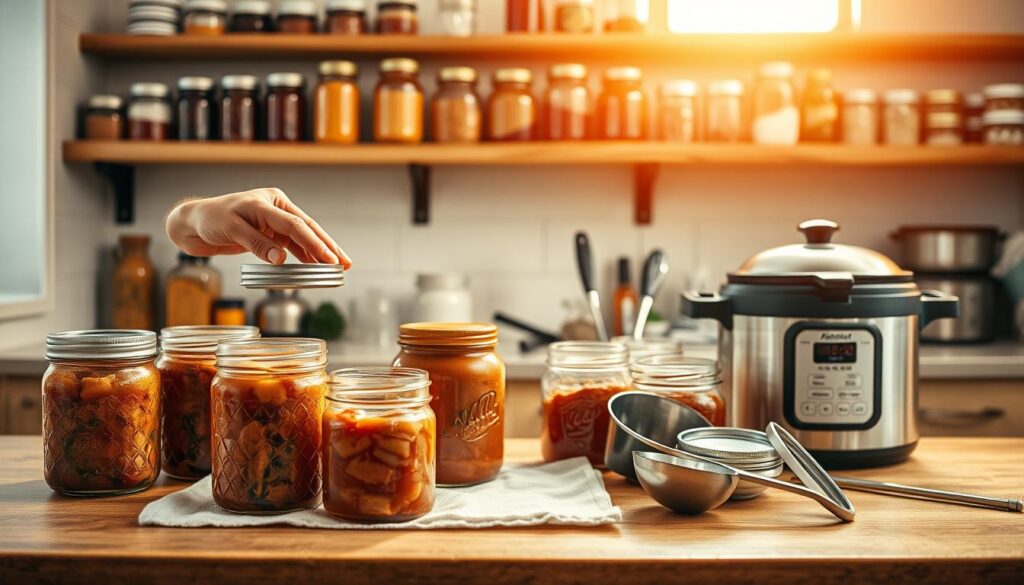
Preservation Best Practices
Start with clean, sterilized jars and lids. Wash them thoroughly and wipe the rim to ensure a proper seal. Use a pressure canner to safely process your food, maintaining the recommended pressure and cooking time.
For best results, follow these steps:
- Sterilize all equipment before use.
- Pack ingredients tightly, leaving an inch of headspace.
- Wipe the rim clean before sealing the lid.
- Process pints for 75 minutes and quarts for 90 minutes.
Troubleshooting Common Issues
Even with careful preparation, issues can arise. If a jar fails to seal, check the rim for cracks or food residue. Re-process the jar with a new lid if necessary. Uneven cooking may occur if the pressure canner isn’t heated consistently. Monitor the gauge closely to avoid fluctuations.
Here’s a quick reference table for troubleshooting:
| Issue | Solution |
|---|---|
| Improper sealing | Check rim, replace lid, and re-process. |
| Uneven cooking | Maintain steady heat and pressure. |
| Gauge misreads | Calibrate or replace the gauge. |
By following these expert tips, you can ensure your preserved food stays fresh and flavorful. Whether you’re canning venison or other ingredients, these practices will help you achieve professional-quality results every time.
Conclusion
Home canning opens up a world of possibilities for creating flavorful meals with ease. By following the right steps, you can ensure your preserved venison stays safe and delicious. From sterilizing jars to maintaining steady heat in your pressure canner, every detail matters.
Experiment with different seasonings and serving ideas to make the most of your preserved ingredients. Whether it’s a hearty stew or a quick skillet dish, the versatility of venison shines through. Remember to check the lid seal and monitor the liquid levels for consistent results.
We encourage you to try the recipes and techniques shared in this guide. With practice, you’ll master the art of home canning and enjoy meals that are both convenient and satisfying. Share your success stories and explore more resources to continue your canning journey!
FAQ
What tools do I need for canning venison?
Essential tools include a pressure canner, jars, lids, rings, a jar lifter, and a rack. You’ll also need ingredients like salt, pepper, and optional seasonings for flavor.
How long does it take to process venison in a pressure canner?
Processing time depends on the method and jar size. For pint jars, it typically takes 75 minutes, while quart jars require 90 minutes at the recommended pressure.
Can I add vegetables to my canned venison?
Yes! Adding ingredients like onion, garlic, or potato enhances flavor. Ensure they’re cut into uniform pieces for even cooking and safe preservation.
What’s the difference between raw pack and pre-cooked methods?
Raw pack involves placing uncooked venison into jars, while pre-cooked requires browning the meat first. Both methods work, but pre-cooking can intensify flavor.
How do I ensure my canned venison is safe to eat?
Always follow pressure canning guidelines, use tested recipes, and check the gauge for accuracy. Properly wipe jar rims and seal lids tightly to prevent contamination.
What are some creative ways to use canned venison?
Try it in stews, soups, or sandwiches. It’s also great for quick meals like pot roasts or as a protein boost in vegetable dishes.
How do I troubleshoot common canning issues?
If jars don’t seal, check for debris on the rim or damaged lids. For cloudy liquid, ensure you’re using distilled water and avoid overpacking jars.
Can I adjust the seasoning in my canned venison?
Absolutely! Experiment with minced garlic, pepper, or herbs like rosemary. Just avoid over-seasoning, as flavors intensify during the canning process.






